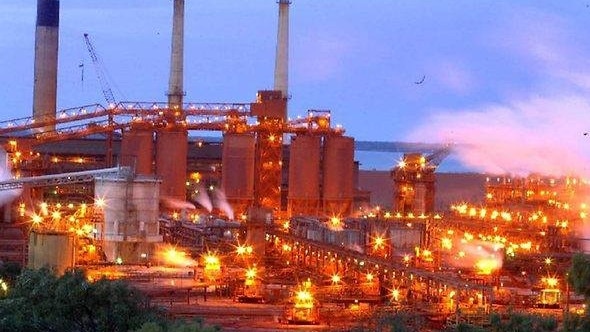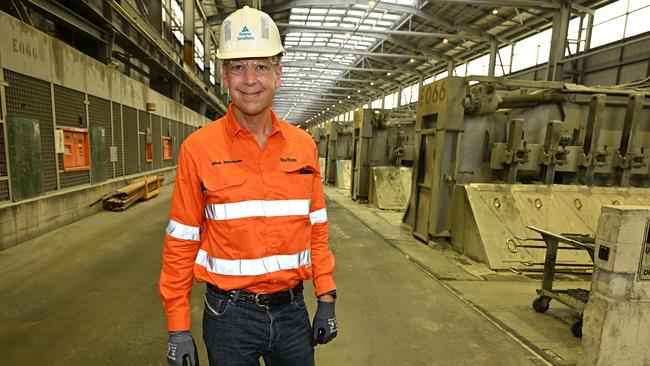Green power: Rio Tinto’s $1bn deal to drive giant solar farm
Under a new power purchase agreement signed with European Energy Australia, Rio Tinto will buy all power generated from the Upper Calliope solar farm for 25 years.
Resources giant Rio Tinto has sealed a $1bn deal to buy huge amounts of solar power to drive its aluminium production in the Queensland industrial city of Gladstone.
Under the 25-year agreement, with European Energy Australia, Rio Tinto will buy all electricity from the 1.1GW1 Upper Calliope Solar Farm.
The agreement comes as the Australian Energy Market Operator warned there was lack of reserve electricity generation to meet record high demand in Queensland amid hot and humid weather. Once complete, the farm will provide enough electricity to meet about 5 per cent of Queensland’s current demand.
The deal is expected to provide greater certainty for Rio Tinto’s operations in Gladstone. Last year, Rio Tinto completely wrote off the value of its Boyne aluminium smelter in Gladstone, blaming high energy costs.
Rio Tinto said the deal will bring more renewable power into one of Australia’s most important industrial hubs and marks another step towards its climate goal of halving its global carbon emissions this decade,
The plant will be built and operated by European Energy, at a site about 50 kilometres southwest of Gladstone, pending development and grid connection approvals. Once approved and developed, Upper Calliope would have the potential to lower Rio Tinto’s operating carbon emissions by 1.8 million tonnes per year.
Rio Tinto is seeking long-term power to power its three Gladstone production assets – the Boyne aluminium smelter, the Yarwun alumina refinery and the Queensland Alumina refinery.
The assets require more than 1GW of reliable power to operate, which equates to over 4GW of quality wind or solar power with firming.

Rio Tinto chief executive Jakob Stausholm said the agreement was a first important step to repower its Gladstone operations and illustrates a commitment to keeping sustainably powered industry in Central Queensland.
“The task remains challenging, but we have a pathway to provide the competitive, firmed power our Gladstone plants need, and we are continuing to work hard with all stakeholders, including the Queensland and Australian governments, on getting there,” said Mr Stausholm.
“Competitive capacity, firming, and transmission, are critical to developing a modern energy system that can ensure more large-scale renewables development in Queensland and help guarantee the future of Australian industry.”
Construction of the solar farm is targeted to start in 2025 or 2026 is expected to take two years to construct, It will cover 2400 hectares, employ 1000 people during construction and support 100 direct and indirect jobs when operating.

Australian Aluminium Council chief executive Marghanita Johnson said the deal was “exciting news” for Australia’s aluminium industry.
“While this is the first step and still requires firming and transmission, it indicates that this is an industry with real opportunity and potential to transition to a clean energy future,” said Ms Johnson. She said aluminium was a key global driver to a clean energy future.
“Australia has a large bauxite resource and alumina refining, aluminium smelting and downstream manufacturing base, and under the right framework has the potential for future large scale, low-emissions industrial production,” she said.
European Energy chief Erik Andersen said the company was proud to be a strategic partner in this project that aligned perfectly with Rio Tinto’s ambitious climate goals.
“The Upper Calliope Solar Farm is not just a solar power project; it’s a testament to our shared vision for a greener future,” said Mr Andersen.
“By supplying renewable energy to one of Australia’s key industrial hubs, we are setting a new standard for industrial energy consumption.”
Australian Conservation Foundation climate and energy campaigner Jaclyn McCosker welcomed the investment as as it indicated Queensland’s biggest energy consumer was serious about using large-scale solar to power its energy-hungry aluminium refineries and smelters in Gladstone. “It is a step in the right direction for a company that is aiming to completely decarbonise its Gladstone operations,” said Ms McCosker.






To join the conversation, please log in. Don't have an account? Register
Join the conversation, you are commenting as Logout